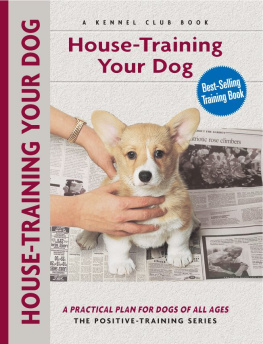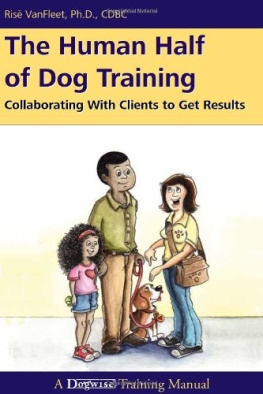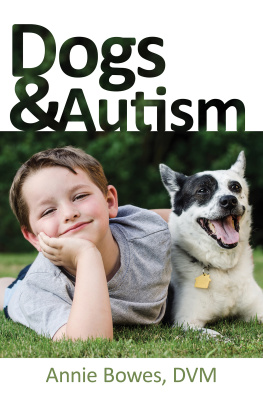APPENDIX
Terry Ryan
For more information on Terrys seminars and training classes, contact:
Legacy Canine
P.O. Box 3909
Sequim, WA 98302
360-683-1522
Terry@LegacyCanine.com
www.legacycanine.com
Dogs and Dog Breeds
American Kennel Club (AKC)
260 Madison Avenue
New York, NY 10016
212-696-8200
www.akc.org.
Further Reading
After You Get Your Puppy by Ian Dunbar. James and Kenneth Publishers, 2001.
Calming Signals: Visit the Turid Rugaas Web site at http://www.canis.no/rugaas/.
Click for Joy! Questions and Answers from Clicker Trainers and Their Dogs by Melissa C. Alexander and Robert Bailey. Sunshine Books, 2003.
Dogs: A Startling New Understanding of Canine Origin, Behavior and Evolution by Raymond Coppinger and Lorna Coppinger. Scribner, 2001.
Dont Shoot the Dog! The New Art of Teaching and Training by Karen Pryor. Bantam Books, 1999.
Excel-Erated Learning: Explaining in Plain English How Dogs Learn and How Best to Teach Them by Pamela J. Reid. James and Kenneth Publishers, 1996.
The Study of Instinct by Nikolaas Tinbergen. Oxford University Press (paperback reprint edition), 1991.
FOR PROFESSIONAL TRAINERS
Coaching People to Train Their Dogs: A Manual for Pet Dog Class Instruction by Terry Ryan. Legacy Canine Behavior and Training, Inc., 2005.
Head Collars
If you would like to try a training tool to help teach your dog to walk nicely on a leash, we recommend the Gentle Leader brand head collar, by Premier, 406 Branchway Road, Richmond, VA 23236. Phone 1-888-640-8840 (804-379-4702 in the Richmond, Virginia, area) or visit www.gentleleader.com. Gentle Leader head collars are also sold in many local pet supply stores and Internet-based pet supply stores.
Professional Dog Training and Canine Behaviorist Organizations
Animal Behavior Associates, Inc.
4994 South Independence Way
Littleton, CO 80123
303-932-9095
info@AnimalBehaviorAssociates.com
Association of Pet Dog Trainers (APDT)
5096 Sand Road SE
Iowa City, IA 52240-8217
1-800-PET-DOGS
information@apdt.com
www.apdt.com
National Association of Dog Obedience Instructors (NADOI)
PMB 369
729 Grapevine Highway
Hurst, TX 76054-2085
http://www.nadoi.org
Chapter 1 OUTWITTING DOGS: IT REALLY IS POSSIBLE
A Canadian psychologist is selling a video that teaches you how to test your dogs IQ. Heres how it works: If you spend $12.99 for the video, your dog is smarter than you.
Jay Leno
If youre going to get a dog, theres something you need to face: Some amount of accommodation is inevitable. Youre going to have to give something up. Maybe lots of things.
Now, it may be that you already realize this, because you already have a dog. At this point, the first thing to do is take a deep breath and relax. Your life has changed. Well, half the battle is your mental attitude. You can get through this.
But what if you dont have a dog yet? Maybe youre only thinking about it at this point. Maybe the kids are begging you for a dog and youre about to give in. Or maybe youre a cat person whos just proposed marriage to a dog person and you want to know what youre up against. Or maybe you had a dog as a kid, and now that youre an adult youd like to get one again. Your parents did all the training the first time; now you want an idea of how to go about it yourself before you take the plunge.
Whatever the situation is, you have your routine, your living space, your stuff. You probably have a job or will at some point in the next 10 or 15 years. You may have other pets, who may, incidentally, look like food or toys to a dog.
So lets take a look at how bringing a dog into your life is going to change it.
For Anyone Thinking of Getting a Dog...
Dogs are dependent. They have physical needs that crop up every few hours, regardless of your mood or your schedule. Theyre social animals. They arent happy if left alone for long periods of time. Theyre active animals. They cant be confined for too long, and if you dont give them things to do theyll make up their own fun. In other words, theyre demanding.
Dogs also have their little quirks. They love to chew, for example. Chewing, to a dog, is as fun as watching television or reading a book is to a human. Its great recreation. Its a way to relax. Its what dogs like to do when theres nothing else going on. Whats more, dogs arent born knowing the difference between a $2 piece of rawhide and a $2,000 leather chair. They both chew real good, to a dog.
Another quirk about dogs: They arent very good with flush toilets. To them, the ground is a toilet. And from a dogs perspective, the ground includes the floors inside your houseunless you teach your dog the difference.
So what does that mean to you? It means that, before you get that dog, you need to prepare yourself mentally. From now on, your routine is going to revolve, to some extent, around your dog. Youre going to have to adjust your life to make sure your dog gets enough exercise, potty breaks, training, and attention. Every day. And while youre at it, you should prepare yourself mentally for the possibility of seeing some of your stuff get damaged, especially if your new friend is coming as a puppy.
There are some extreme steps you can take to minimize your risks. You could, for example, buy a house that is completely tiled inside, withdrain holes in the floor of each room, kind of like the shower room at the local health club. That way, if you run into a little trouble house-training your dog, no problemjust hose things down.
You may also think about selling any furniture thats worth any money or storing any that has sentimental value. Replace it with junk you pick up on the curb on garbage day and presto: No more worrying about a dog gnawing on a chair leg.
Outside, you could consider replacing your flower beds and lawn with gravel. Then if your dog wants to dig, who cares? Just rake the stones once a week or so to level things out, and youre done. (No more mowing, either!)
Okay, so these options sound a bit extreme. Plus, if you have any other humans living with you, they might object.
So whats a more reasonable way to prepare?
The first step, odd as it may sound, is to pick the right dog. Get this step right, and you solve a whole bunch of problemsby avoiding them in the first place.
Preparation Step 1: Picking the Right Dog
To pick the right dog, you need to understand what type of dog will best fit you, your family, and your lifestyle. Suppose youre shopping for a purebred dog. And suppose youre a couch potato who thinks opening the refrigerator door qualifies as an aerobic workout. Youd be crazy to adopt a dog bred for physical work. Dogs bred to hunt (like Weimaraners or coon hounds) or herd (like Border Collies or Australian Shepherds) are often high-energy animals who need hours of exercise a day. If they dont get that exercise, they might find other ways to burn off their energy, like eating your wallswhile youre trying to catch a nap.
If, on the other hand, you jog 12 miles a day and think power-climbing mountains is a great way to spend your weekends, dont pick a little lapdog who was bred to sit quietly and warm the legs of royal courtiers. The little guy will struggle to keep up with you. Unless you plan on carrying him while you scale your peaks.
Part of what were talking about here is what dog people call temperament. Think of it as a dogs basic personality. Dogs can be lively and high-energy, or laid-back. They can be outgoing or introverted. Some welcome new experiences. Others take a wait-and-see attitude about new things.












